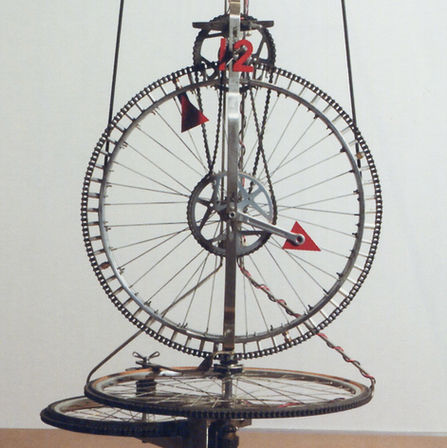The Conical Pendulum Clock
Norman Tuck ©1986
21 feet high x 6 feet wide x 6 feet deep
requires a ceiling height of 23 feet (7 meters).
See Pages 53-54 of Slideshow
See video at: https://vimeo.com/109288956
An Obscure Timekeeper Reborn.
Possibly the largest conical pendulum clock in existence.
The Conical Pendulum Clock is currently in the collection of the Artist.
The Conical Pendulum Clock was created by Norman Tuck in 1986 as an Artist-In-Residence project at the New York Hall of Science in Queens, New York.
The clock is gravity driven, powered by a falling weight that hangs from a pully via red urethane belting. The belting wraps around a vertical bicycle wheel (the minutes wheel). Regulated by the pendulum, the wheel takes a precise hour to rotate. A red arrow mounted onto the wheel acts as the minute hand. Every few minutes (+ - 8 min.) the falling weight triggers a sealed mercury switch to trigger an electric motor that raises the weights using the principal of Huygens’ Endless Chain.
A hanging plumb-bob forms the pendulum of this unusual clock. The hanging bob navigates a circle around the entire clockwork mechanism in the amount of time that a conventional swinging pendulum of the same length would take to oscillate. Governed by the pendulum, each rotation takes precisely five seconds.
The pendulum restricts the impulse of the weight-driven drive train that propels it with a yellow fishing rod. The rod pushes the pendulum along and the drive train records the number of five-second revolutions.
The “wheels” on this clock were created by welding links of industrial roller chain (bicycle style chain) together to form giant “lantern gears” that mesh with toothed bicycle sprockets. These rings of chain are mounted onto bicycle wheels to form the large open drivetrain of the clock.
Thus, this mechanism uses weights and a series of gears to propel an accurately oscillating body (the pendulum) and to record the number of oscillations and convert this to standard units of time. It is a clock.
The Conical Pendulum Clock has been exhibited at: The New York Hall of Science, Queens, NY, 1986; Southeastern Center for Contemporary Art, Winston-Salem, NC, 1991; Technorama Museum, Winterthur, Switzerland. 1993; The Liberty Science Center, Jersey City, NJ, 1994; The Exploratorium, San Francisco, CA, 1994; Inventure Place, Akron, OH, 1996; phaeno Museum, Wolfsburg, Germany, 2008; and Parque de las Ciencias, Granada, Spain, 2009.
From Wikipedia:
A conical pendulum consists of a weight (or bob) fixed on the end of a string or rod suspended from a pivot. Its construction is similar to an ordinary pendulum; however, instead of swinging back and forth, the bob of a conical pendulum moves at a constant speed in a circle with the string (or rod) tracing out a cone. The conical pendulum was first studied by the English scientist Robert Hooke around 1660 as a model for the orbital motion of planets. In 1673 Dutch scientist Christiaan Huygens calculated its period, using his new concept of centrifugal force in his book Horologium Oscillatorium. Later it was used as the timekeeping element in a few mechanical clocks and other clockwork timing devices.


The Conical Pendulum Clock has been exhibited at:
The New York Hall of Science, Queens, NY. 1986
Southeastern Center for Contemporary Art, Winston-Salem, NC. 1991
Technorama Museum, Winterthur, Switzerland. 1993
The Liberty Science Center, Jersey City, NJ. 1994
The Exploratorium, San Francisco, CA. 1994
Inventure Place, Akron, OH. 1996
phaeno Museum, Wolfsburg, Germany. 2008
Parque de las Ciencias, Granada, Spain. 2009

The source drawing for the conical pendulum found in
The Engineers" Illustrated Thesaurus
©1952, by Herbert Herkimer.







